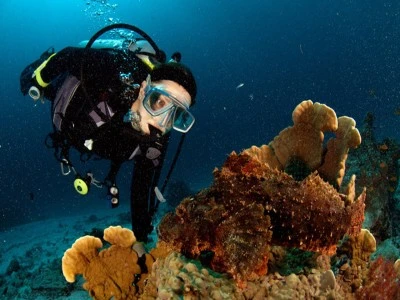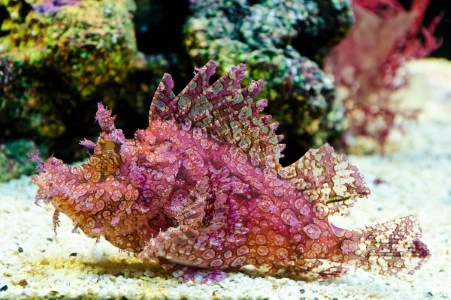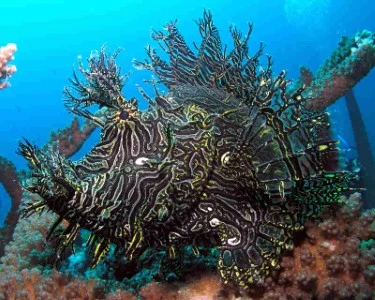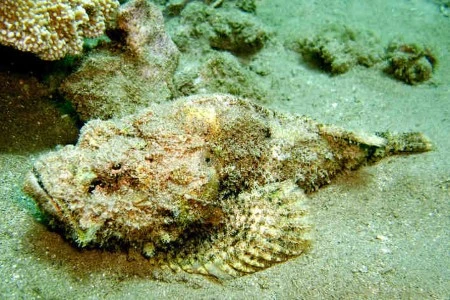Scorpionfish are among the ocean’s most fascinating and enigmatic creatures, captivating divers with their extraordinary camouflage and formidable venomous spines. Belonging to the family Scorpaenidae, these ambush predators are found in tropical and temperate waters worldwide, often blending seamlessly into coral reefs, rocky outcrops, or sandy seabeds.

Their ability to remain motionless while waiting for prey makes them both a thrilling discovery and a potential hazard for unsuspecting divers – scuba diving with scorpionfish is not a hands-on experience! Scorpionfish exhibit a stunning diversity of shapes, colours, and behaviours that make them a highlight, and a cautionary tale, for scuba divers.
Encountering a scorpionfish in its natural habitat is a test of a diver’s observational skills, as their mottled patterns and algae-covered spines render them nearly invisible. While their venomous dorsal spines serve as a defence mechanism, these fish are generally non-aggressive unless provoked. Divers who take the time to observe them carefully may witness their patient hunting strategy, where they strike with lightning speed to engulf small fish and crustaceans. However, accidental contact can lead to painful stings, making buoyancy control and respectful distancing essential when diving near these masters of disguise.
For underwater photographers and marine life enthusiasts, scorpionfish offer a rewarding challenge, combining striking beauty with elusive behaviour. Their presence also highlights the delicate balance of reef ecosystems, where they play a crucial role as both predator and prey. Diving with scorpionfish is a reminder of the ocean’s wonders and the importance of treading carefully when in their domain.
Scorpionfish Fact Sheet
Family name: Scorpaenidae
Order name: Scorpaeniformes
Common name: Scorpionfish
Scientific name: Scorpaenidae
It is easy to make mistakes when trying to identify different species when diving with scorpionfish. Even the ‘fish authorities’ are undecided on how the family fits together. ‘Fishes of the World’ recognises almost 400 species and 10 subfamilies, and Fishbase lists a much lower 172 species and 3 subfamilies. They do all agree that the flamboyant lionfish, deadly stonefish, well camouflaged leaffish are all cousins of the scorpionfish.
Distinguishing Features

Scorpionfish vary in length, between 14-45 cm, have large uneven, spiny heads with numerous spines and ridges, and compact bodies that are well-camouflaged to come in a variety of colours to suit their habitat. Their well developed pectoral fins can be used to ‘walk’ along the sea floor to flush our prey.
They are often mistaken for stonefish, although they are longer and wider than the more round stonefish. The scorpionfish’s eyes protrude, while the stonefish’s eyes are more recessed into the skull. The scorpionfish has a more distinct jaw, and the stonefish’s mouth resembles a grumpy toddler. They have venomous spines on their dorsal, anal, and pelvic fins, but those of the stonefish make it the deadliest fish in the sea.
Behaviour
Camouflage is key to the survival of this sedentary species. Generally this means blending in with the surroundings, whether this is in murky mud or being unnoticeable among Pocillopora spp. corals.
Their colouration includes a dull yellow, grey, brown or rust, with some light blotches. Yet they also exhibit bright colour warnings that are typical of many highly venomous creatures.
Living a lifestyle akin to a couch potato enables algae or other pests to take up residence on these fish. In order to rid themselves of any attached algae, cyanobacteria and even parasites, they have the ability to shed the outermost skin layer, the cuticle.

Feeding Habits
All Scorpaenids are equipped with a large mouth, capable of swallowing prey over half their own body length! They are nocturnal carnivores and prey on crustaceans, cephalopods (such as squid, octopus and cuttlefish) and other small fish. They rely on their camouflage and their ‘hoover’ like ability to literally inhale their unsuspecting meal in an instant.
Reproduction & Life Cycle
Their mating dance includes non-destructive fin nipping, gill cover flaring and side-to side rocking. The female releases between 2,000 – 15,000 eggs that are fertilised by the male before they float to the surface in the greenish gelatinous walls of hollow pear-shaped sacks that sort of look like balloons. The eggs hatch after just 5 days and the fry remain at the surface together with plankton until they are about 2.5 cm long.
They then make their way down to the safety of the reef. In captivity they have an average lifespan of 10-15 years, however in the wild this would be significantly lower.
Predation
Once the young have successfully survived their juvenile days, scorpionfish have few predators. Who would want to snack on a spikey venomous bony fish anyway?
Many scorpionfish have the ability to effectively display their different colours, using a behaviour to deter predators called “flashing”, when they expose the usually concealed colours.

Distribution and Habitat
Scorpaenidae are found across vast areas of the Indo-Pacific. They are highly adaptable and live in the colder regions of the world’s oceans, in temperate and tropical waters, as well as in brackish and even freshwater.
They are generally found in shallower waters, however in July 2016 a new species was found way beyond diving depths off the Caribbean island of Curaçao. The new species can be found between 95-160m and was officially named Scorpaenodes barrybrowni in honour of Substation Curaçao and freelance photographer Barry Brown.
Ecological Considerations
Habitat loss from dying reefs, as a result coral bleaching and ocean acidification are the main ecological dangers facing all reef dwellers, including scorpionfish. Destructive fishing practices also contribute to such habitat loss. Although tricky to handle and voracious predators, scorpionfish are quite popular among aquarium owners.
Dive Sites for Scorpionfish
There are a great many diving destinations for encounters with these cryptic creatures, with some of the best being:
Caribbean Sea / Atlantic Ocean
| • Bahamas | • Belize |
| • British Virgin Islands | • Cayman Islands |
| • Cuba | • Honduras |
| • Saba / St. Kitts | • Turks and Caicos Islands |
Oceania
| • Australia | • Chuuk |
| • Fiji | • Palau |
| • Solomon Islands | |